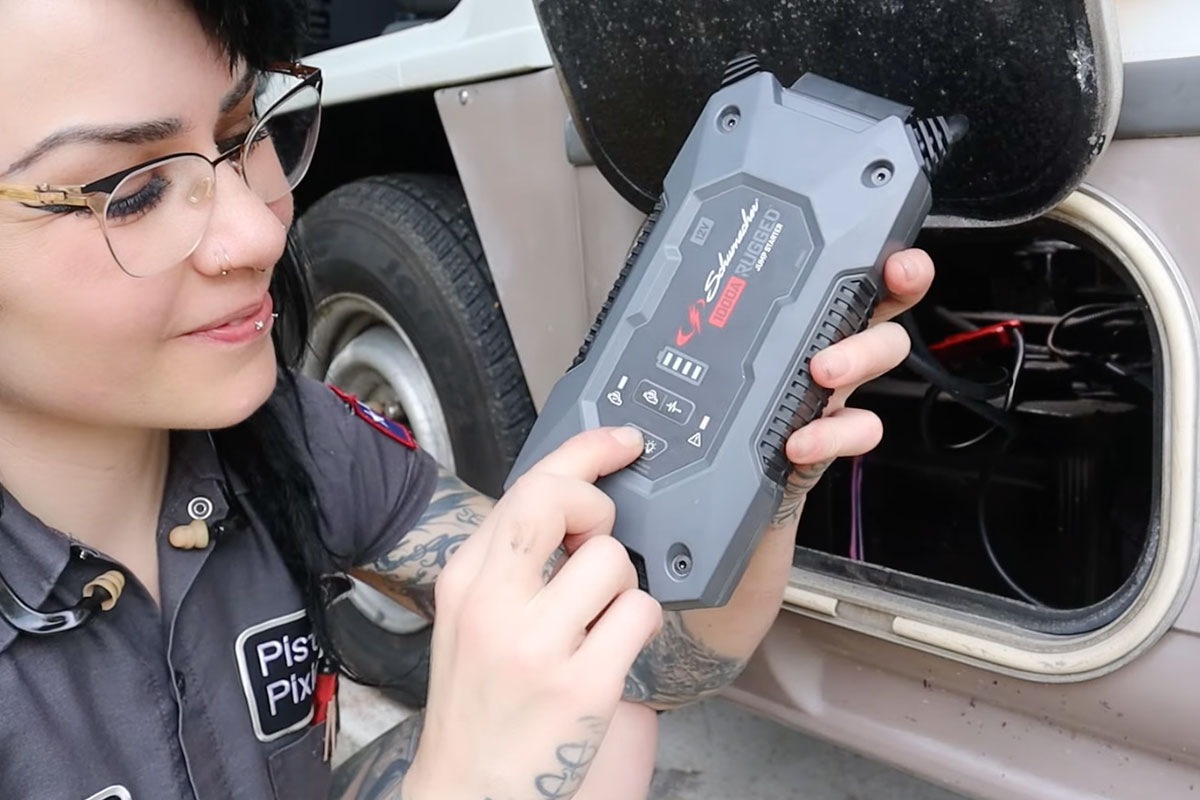Battling the Cold: Tips to Revive a Dead Car Battery and Prevent Cold Weather Woes
Welcome to Schumacher Electric’s comprehensive guide on dealing with car battery woes in cold weather. As winter chill settles in, the frigid temperatures can wreak havoc on our vehicles, especially car batteries. Whether you’ve already experienced the frustration of a dead battery or want to stay proactive in preventing such issues, this blog post has […]

Welcome to Schumacher Electric’s comprehensive guide on dealing with car battery woes in cold weather. As winter chill settles in, the frigid temperatures can wreak havoc on our vehicles, especially car batteries. Whether you’ve already experienced the frustration of a dead battery or want to stay proactive in preventing such issues, this blog post has got you covered. We’ll dive into the impact of cold weather on car batteries, provide step-by-step instructions for reviving a dead battery, offer tips for safeguarding your battery from the cold, recommend essential equipment to keep your battery in top shape, and more. Don’t let winter catch you off guard – read on to discover how to keep your car battery healthy and your vehicle running smoothly even in the roughest winter conditions.
Understanding the Impact of Cold Weather on Car Batteries
If it seems like every winter your car is harder to start or experiences more battery issues, you aren’t imagining things. Colder weather does negatively impact a battery’s performance, for several reasons.
- Heat damage – It may seem counterintuitive to blame winter battery issues on the heat, but oftentimes damage caused by high summer temperatures can reduce your battery’s lifespan. This can result in a battery that just can’t make it through the winter.
- Diminished Battery Capacity – To start your vehicle, your battery must provide a certain amount of energy to successfully crank the engine. In cold temperatures, this will require even more energy from your battery, making it work harder to provide the energy needed to activate the starter motor and crank the engine. And while your battery needs to provide more energy in the cold, its capacity also diminishes. In fact, when the temperature is at 32°F, your battery will lose about 20 percent of its capacity and will lose even more capacity as the temperature falls.[1]
- Slower Recharge Rate – In normal conditions, your car’s alternator will recharge the battery while you are driving. However, during winter or periods of low temperatures the alternator will take more time to recharge your battery, meaning a short trip may not give your battery enough time to be fully recharged.
- Amplified Power Requirements – When it’s cold outside it’s likely that you will use more accessories in your vehicles—windshield wipers, defrosters, heaters—which will increase the power demand on your battery, which further slows the recharge rate and lengthens the time required to fully recharge your battery.
- Thickened Engine Oil – Engine oil must flow smoothly through your engine in order for your car to start. When it is extremely cold outside, it thickens, which makes it harder to crank the engine and strains your battery.
Signs of a Dying Battery in Cold Weather
Now that you understand why cold weather is so tough on your battery, be on the lookout for signs that your battery is failing. It is always better to catch the problem early than to find yourself stranded in a dark parking lot with a dead battery on a cold evening.
- Engine cranks slowly – If while cranking your engine seems to be sluggish, this could be a sign that your battery is in trouble. It can also be a sign of more serious issues, such as a problem with your vehicle’s electrical system or a failing starter motor. So, if you experience this symptom, drive straight to a mechanic shop or auto parts store to have your battery tested and replaced if necessary.
- Headlights and interior lights appear dim – If you notice that your car’s headlights seem weaker or dimmer than usual, a failing battery may be to blame.
- The car’s electronics malfunction – Some newer vehicles will shut down non-essential functions when they detect a failing battery. So, if your radio stops working you might just need to replace your battery.
- A warning light comes on while driving or stays illuminated after starting – Many newer cars can detect a low battery charge and will turn on a battery light or flash a message about your battery. In older cars, you might get a more general “check engine” warning. If warning lights start to flash, don’t ignore them. Have them checked immediately.
- The battery appears swollen or damaged – Extreme temperatures or other damage can cause your battery to leak, swell, vent gasses, and, in extreme cases, explode. If you notice visible damage to the battery, do not drive your vehicle until the battery has been replaced.
- Your battery is old – Vehicle batteries have a finite lifespan, usually 3 to 5 years, although they can fail sooner or last beyond that window. If your battery is older than three years, have it tested to ensure it is up to the challenge of winter weather or if it needs to be replaced.
Reviving a Dead Battery in the Cold: Step-by-Step Guide
If you have a dead battery, the only short-term solution is to jump start the battery. To do this, you’ll need either a jump starter or a set of jumper cables and someone with a running car who is willing to give you a jump.
The easier of the two options is to use a modern jump pack. These portable lithium-powered units are compact and lightweight, so you can take them with you in a glove box, center console, or backpack. For those in colder climates, you should consider a jump starter that has a pre-heat function to warm up your battery before jump starting and one with enough power to start your vehicle in cold weather. Modern jump packs are also easy to use. While exact operating steps will vary (refer to the jump pack’s user manual), you will usually connect the clamps as directed, press a button, and then start your vehicle.
If you choose to use jumper cables, make sure you use cables with a low AWG (American Wire Gauge) number as these will conduct energy more efficiently, especially in cold weather.
- Position the two vehicles close enough that your cables can reach the battery in each vehicle.
- Turn off the ignition in both vehicles, as well as all accessories, such as headlights, radios, heaters, etc.
- Engage both vehicles’ emergency brakes.
- Raise the hood or access to the vehicle battery and locate the battery terminals. If the terminals are corroded, remove the corrosion with a wire brush.
- Connect the clamps as directed in your vehicle’s owner’s manual. This will usually be the red clamp to the positive terminal in both vehicles. The black clamps to the negative terminal in the donor car and to the vehicle chassis in the car that won’t start.
- Start the engine of the donor car first. Then crank the engine of the second vehicle.
- After it starts, disconnect the battery cables.
- Drive the car that was just started for at least 20 minutes to recharge the battery. Note: This will take longer in cold weather.
Preemptive Measures: How to Safeguard Your Battery from the Cold
While there are remedies for a dead battery, prevention is better for your battery’s health and lifespan and safer for you, the driver. Here are nine easy steps you can take to prevent a dead battery.
- Drive your car regularly – When your car is parked for extended periods, such as a week or longer, it can self-discharge. If you must leave your vehicle idle, using a battery maintainer will combat self-discharge and help maintain a full charge and battery health.
- Avoid short trips – In moderate temperatures it will take 20-30 minutes of driving at highway speeds to fully recharge your vehicle’s battery. It takes even longer in low temperatures. Short trips won’t give your battery the opportunity to fully recharge, so the next time you start your vehicle you’ll do so with a partially charged battery.
- Park in a garage – This is one of the easiest things to do to protect your battery from hot or cold temperatures. A garage helps your battery maintain a more moderate temperature, especially in the cold overnight hours.
- Choose a high-quality battery suitable to your climate – A battery with a high cold cranking amps (CCA) rating will deliver more energy to your vehicle during starting and better withstand a heavier load from accessories such as heated seats. A premium battery can also last up to twice as long as a standard flooded battery.
- Perform regular battery maintenance – It’s important to do a monthly visual inspection of your battery. This can identify damage or signs of battery corrosion. Corrosion will make your battery work harder, which is especially detrimental during cold weather.
- Test your battery – It’s a smart move, especially if you live in a climate with temperature extremes, to regularly test your battery. Most auto parts stores will test the battery for you, or you can test it yourself at home with a battery tester. If you test at home, batteries with a reading of at least 12.4 volts are sufficiently charged and should work as intended.[1] If the battery has a reading below 12.4 volts, attempt to charge the battery. If it cannot be recharged, replace the battery immediately. Regular testing, however it occurs, helps you identify potential problems before they happen.
- Insulate your battery – Using an insulation kit or thermal barrier will help your battery maintain a stable temperature and provide protection from extreme cold.
- Don’t run lights or accessories with the ignition off – Reduce the load on your battery by turning off non-essential items such as lights and car radios. Even items like phone chargers can be a drain on your battery.
- Use a battery charger and maintainer – Battery chargers and maintainers are ideal for vehicles that will sit unused for more than a week. Once your battery reaches a full charge, they will supply your battery with only enough power to offset its discharge rate. A good automatic charger/maintainer will keep your battery in top condition, extending its lifespan and making sure it starts on the first try.
Essential Tools and Equipment for Cold Weather Battery Maintenance
Having a few battery care tools on hand can ensure that your battery makes it safely through the winter season. Whether it’s a simple battery tester, a portable jump starter, or battery charger/maintainer for your garage, these tools will each decrease your chances of becoming stranded in the cold by a weak or dead battery.
Battery Tester
Schumacher 100A 6V/12V Battery Load Tester and Voltmeter (BT-100)
It’s important to regularly test your battery, especially if it is over 3 years old or exposed to extreme temperatures. The Schumacher BT-100 is designed to test 6V and 12V batteries up to 1000 cranking amps and will also test your vehicle’s charging system. This tool will let you test load, battery condition, and starter motor draw with a 50A load test for 6V batteries and a 100A load test for 12V batteries. It’s also simple enough for even novices to use. Simply connect the unit’s clamps and follow the steps for your chosen test. The results will appear on the full-color analog meter.
Jump Starters
Schumacher Lithium Portable Power Pack and 1000A 12V Jump Starter (SL1639)
Designed to start up to 8.0L gas and 6.0L diesel engines, the Schumacher SL1639 jump starter is compatible with a range of vehicles including cars, motorcycles, boats, SUVs, and trucks. However, its major advantage is its small size. Due to its compact and lightweight nature, the SL1639 can be easily carried in a purse or backpack, added to your car’s winter emergency kit, or placed in your vehicle’s glove box. It’s also long lasting with a fast recharge, allowing up to 30 jump starts on a single charge and then recharging in 2.5 to 4 hours. The unit also functions as a power bank that recharges smartphones, tablets, wearables, and other items that might be essential in an emergency. Plus, there’s a built-in LED light with three modes – steady, flashing (SOS), and strobe – to increase your visibility after dark.
Schumacher SL1562 Lithium Portable Power Station and 1200 Peak Amp 12V Jump Starter (SL1562)
If you’d prefer a multi-function jump starter that is still relatively compact and lightweight, you should look to the Schumacher SL1562. This device is a jump starter, USB power station, 150-PSI air compressor, and emergency light all in one. The SL1562 is perfect to keep on hand in your garage and will help you perform a range of tasks. The 1200 peak amps will jump up to 8.0L gas and 6.0L diesel engines in cars, trucks, motorcycles, boats, marine batteries, SUVs, ATVs, and more. The 2.4A USB port charges up to two times faster than a standard USB charger[1] and is perfect for tailgating, camping, and emergency power. With the 150-PSI air compressor you can ensure your tires are always properly inflated or fix a flat soccer ball before after-school practice. The LED light comes in handy when jump starting a vehicle and can also serve as a vital source of light if the power goes out.
Rugged by Schumacher 2000 Peak Amp 12V Portable Lithium Jump Starter and USB Power Pack (SL1612)
This winter, if you want the peace of mind brought by a seriously powerful jump starter, consider purchasing the Rugged by Schumacher SL1612 2000 peak amp jump starter. This jump starter is powerful enough to jump start just about any passenger vehicle up to 10.0L gas and 8.0L diesel. Plus, it features Schumacher’s Pre-Heating technology that warms batteries in cold temperatures for better starting conditions. It also has a Pre-Boost feature that adds a pre-charge to deeply discharged batteries to deliver easier starting. Other advantages of the Rugged by Schumacher SL1612 are three times faster recharge time[2], seven times lighter weight[3], six times longer shelf life[4], up to 45 jump starts on a single charge, and a 2.4A USB port for two times faster charging[5]. It also boasts a built-in LED area light, 36-inch heavyweight jumper cables and multiple safety features for easy and safe jump starting.
Battery Chargers/Maintainers
Schumacher 100A 6V/12V Fully Automatic Battery Charger and Jump Starter with 30A Boost Mode (SC1281)
If preventing battery issues is your preferred approach, a battery charger and maintainer is the tool for you. The Schumacher SC1281 is a fully automatic battery charger/maintainer and jump starter in one. It even features a built-in battery and alternator tester. The SC1281 delivers 100 cranking amp engine start, a 30A boost, and 6A<>2A charge/maintain rates that are suitable for a wide range of vehicles with standard, AGM, gel, and deep-cycle batteries. Fully automatic, this charger features multi-stage charging, float mode monitoring, and reverse hook-up protection, all designed to maintain battery health and extend your battery’s lifespan. With this device, you’ll have a complete set of tools to keep your battery in top condition all year long.
Schumacher 6A 6V/12V Fully Automatic Battery Charger and Maintainer (SC1357)
For basic battery charging and maintaining needs, you can’t beat the Schumacher SC1357. It features 6A charge (12V), 2A charge (6V), and 3A maintain rates. It’s also fully automatic for easy and safe charging with features such as multi-stage charging, auto voltage detection, float mode monitoring, and reverse hook-up protection. It’s compatible with 6V and 12V standard and AGM batteries.
Schumacher 2A 6V/12V Two-Bank Fully Automatic Battery Charger and Maintainer (SC1410)
Instead of purchasing multiple battery chargers/maintainers to charge and maintain multiple batteries, choose a multiple-bank charger that will charge batteries simultaneously. The Schumacher SC1410 is a two-bank charger that can charge and maintain two batteries at once, with each bank outputting 2A for a total output of 4A. With fully automatic operations, the SC1410 features auto voltage detection, multi-stage charging, float mode monitoring, reverse hook-up protection, bad battery detection, non-sparking clamps, and a desulfation mode to help recover sulfated batteries. It also features LED indicators, a hook attachment that lets you hang the device out of the way for added safety, and mounting slots that allow the device to be mounted to a wall or other flat surface. It also comes with two sets of quick-connect battery clamps and two 18-inch, non-fused ring lead harnesses with weather caps.
Enjoy the Winter Season Without Worry
Winter may be the most challenging time of the year for your car battery, but with the right knowledge and precautions, you can efficiently manage any issues that arise. Whether you choose to take a proactive approach by winterizing your vehicle or need to revive a dead battery, the information in this blog will help you do so effectively. Remember, a little preventative maintenance can go a long way in avoiding car battery woes in cold weather. Stay safe, stay warm, and enjoy all the season has to offer with a reliable car battery on your side!
[1] “How to Help Prevent 4 Common Cold Weather Battery Issues,” Firestone, https://www.firestonecompleteautocare.com/blog/batteries/preventing-winter-battery-issues/, Accessed 5 April 2023.
[2] “5 Ways to Extend the Life of Your Car Battery,” Reader’s Digest Canada, https://www.readersdigest.ca/cars/maintenance/extend-life-car-battery/, Accessed 5 April 2023.
[3] 1A USB port
[4] Than traditional AGM jump starters
[5] Than traditional AGM jump starters
[6] Than traditional AGM jump starters [1] Than a 1A USB port




